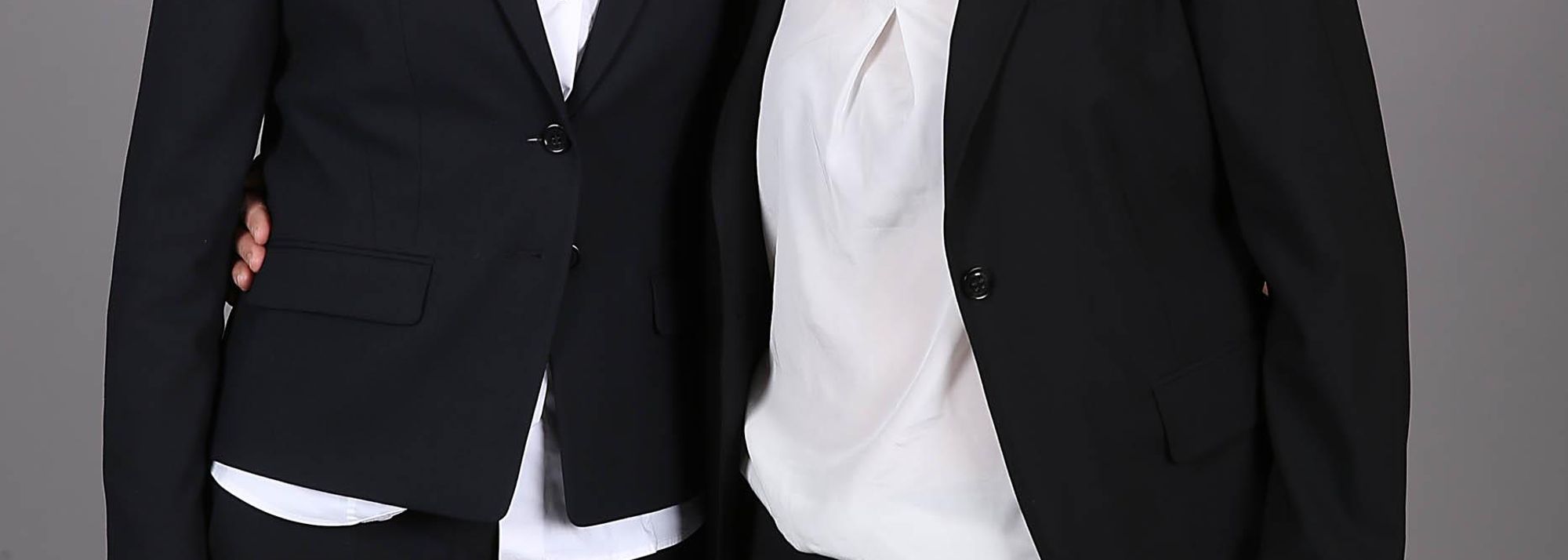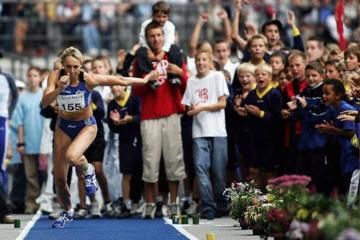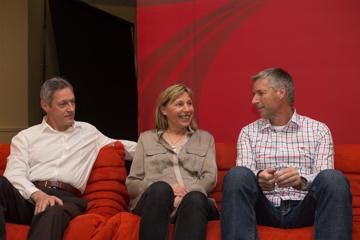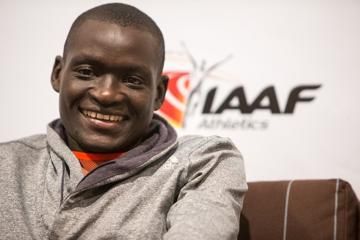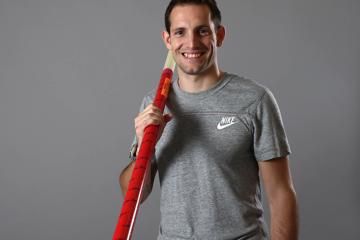Heike Drechsler and Marita Koch ahead of the 2014 World Athletics Gala in Monaco (© Giancarlo Colombo / IAAF)
There are many similarities between Heike Drechsler and Marita Koch. Both are from Germany, both are among this year’s inductees into the IAAF Hall of Fame, both are former world and Olympic champions, both have set multiple world records during their career, and they share the same 200m PB of 21.71, which at the time was a co-held world record.
They even turned up in Monaco wearing near-identical outfits when they spoke to the press ahead of the 2014 World Athletics Gala.
Widely regarded as the best long jumper of all time, Drechsler retired 10 years ago at the age of 39 having won two Olympic titles and four world titles indoors and out. Koch, meanwhile, hung up her spikes in 1987 but still looks back fondly on her career.
“I had a love-hate relationship with the 400m and if I had stuck to just that event, then I wouldn’t have lasted as long,” said Koch, whose world 400m record of 47.60 will celebrate its 30th anniversary next year. “I enjoyed running shorter distances and competing indoors. When I retired in 1987, it wasn’t just because of my achilles, but the fact that I had achieved everything I wanted to. It was the right time to retire from the sport.”
“When I started in athletics, I didn’t think I’d last for as long as I did,” said Drechsler. “I had a wonderful time. I did so many things and I enjoy my sports so much. Maybe that’s why I had such a long career.
“I had some fantastic competitions against Jackie Joyner-Kersee, but the highlight was when I won my last big title in 2000 when I was not that young any more. The media always have problems with age and can’t believe someone can jump well and win the Olympics at 35.
“I was young enough (to continue after reunification). Back in the 1980s, most people retired in their mid-20s. It has only recently become more common for athletes to continue after their 30s. For myself, reunification gave me a new opportunity and I enjoyed my sport in another way.”
Both athletes continue to keep themselves fit today. Drechsler is even contemplating running the Frankfurt Marathon next year.
“I’m taking it step by step,” she said. “I recently ran 14km, which is very far for a long jumper, but I’m really interested in this event and I’m enjoying it very much. Maybe next year I’ll do more running events like this, but it will be just for me, not to test myself against the clock. The marathon is a hard event and it’s a long way, but there’s always a nice atmosphere.”
“I jog about five or six kilometres several times a week,” added Koch. “Every Friday I play basketball or hockey. I wouldn’t run a marathon but I’d be happy to supply the drinks along the way.”
When asked to compare the current approach towards coaching in Germany with that of 30 years ago, Drechsler and Koch agreed that there are significant differences.
“In the East they put everything into sports and we had good coaches from a young age,” said Drechsler. “When you’re young, the important thing is to learn technical things because it’s difficult to change that when you’re older. In German schools now we don’t have as many good coaches to prepare the young. You need a good sports teacher in every town so that young kids can learn good technique.”
“Back in my day there used to be a coach for each event group, from young age up to the elite level,” said Koch. “It’s important to have a good coach-athlete relationship and our coaches helped us with mental strength too; we didn’t need any psychologists. But that’s where it’s lacking at the moment.”
Both Drechsler and Koch were asked about their recollections of the best performances of their careers. For Koch that was, of course, her 400m world record, and for Drechsler it was her 7.63m leap in Sestriere, which would still be the world record today had it not been for the 2.1m/s wind reading.
“We were fortunate that the World Cup was in October in 1985. Normally for East German athletes, once the season was over, that was it. But in 1985 it meant that we still had another solid six weeks of training before the World Cup. I was doing shorter distances in training and I was running 300m half a second faster than before. I was in really good shape.
“In the race itself, my first 100m was good, and after 200m I didn’t feel tired. Even at 300m I felt strong. The last 100m was awful but that’s always the case in the 400m.”
“In Sestriere in 1992 I jumped 7.63m but I didn’t get my Ferrari,” recalled Drechsler of the time when a controversial wind reading denied her of a world record bonus. “It would have been a fantastic world record.
“I was in great shape in 1992, but my weakest competition was the Olympics because I was pushing too much. I only jumped 7.14m, but I was relieved to win by two centimetres.”
Somewhat inevitably, questions concerning doping arose, but Drechsler and Koch highlighted that the problem wasn’t exclusive to 1980s Germany.
“What people have to remember is that athletes who were born in East Germany still trained hard for their results,” said Drechsler. “No one can choose where they are born or where grow up, but I jumped 7.48m in 1988 and then again in 1992, after the wall came down.
“Hopefully Germany has learned from mistakes made in the past. They’re talking of making doping a crime, and that proves they have moved on.”
“Of course many people still point the finger at East Germany, but we have to remember it’s a global problem,” added Koch. “It was back then and it still is these days. It could get worse as the sport gets more commercial and more money is involved. I still have a clear conscience. My only regret is that I didn’t return to the sport after reunification, like Heike did, to prove that I could still run fast.”
Both before and after reunification, Drechsler’s biggest rival was US heptathlete Jackie Joyner-Kersee. She likened their rivalry with the current crop of top high jumpers.
“The men’s high jump is crazy,” said Drechsler. “They have jumped close to Sotomayor’s world record several times. It’s good when there are three or more strong athletes in an event because it really pushes the standard.
“In my time it was the same as I competed against Jackie and [world record-holder Galina] Chistyakova. I’m sure that the only reason I jumped as far as I did is because of Jackie Joyner-Kersee. Whenever I competed against her, I always gave it 180%. Jackie was a fighter in competition, but afterwards she was always very kind. She had something special and is still a good friend.”
Koch and Drechsler will now be joining Joyner-Kersee in the IAAF Hall of Fame; something they are both extremely proud of.
“It was a very pleasant surprise to be added; I didn’t expect it at all,” said Koch. “To be alongside some of the names I looked up to when I was younger – like Seb Coe, and Sergey Bubka – it’s a huge honour.”
“I like the fact that we’ve been added together,” added Drechsler. “Marita was always a team player and she was always very supportive of me when I was younger. And looking at the other athletes on the list, I simply feel lucky that I’m one of the ones still alive!”
Jon Mulkeen for the IAAF
